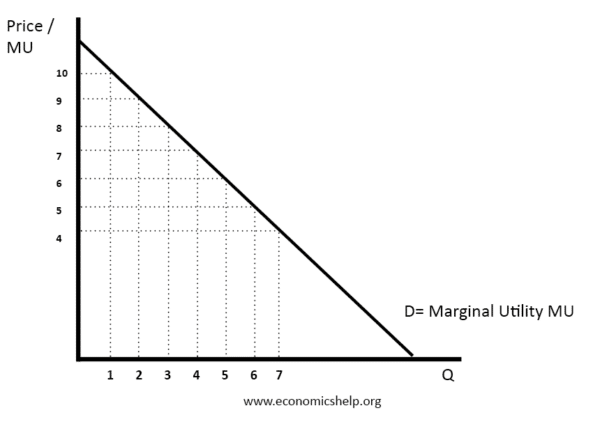Summary: Cardinal utility gives a value of utility to different options. Ordinal utility just ranks in terms of preference.
Cardinal Utility is the idea that economic welfare can be directly observable and be given a value.
For example, people may be able to express the utility that consumption gives for certain goods. For example, if a Nissan car gives 5,000 units of utility, a BMW car would give 8,000 units. This is important for welfare economics which tries to put values on consumption. For example, allocative efficiency is said to occur when Marginal cost = Marginal Utility.
One way to try and put values on goods utility is to see what price they are willing to pay for a good.
If we are willing to pay £5,000 for a second-hand Nissan Car, we can infer we must get 5,000 utils. In other words, the value of cardinal utility is related to the price we are willing to pay.
The idea of cardinal utility is important to rational choice theory. The idea consumers make optimal choices to maximise their utility.
Demand curve showing cardinal utility
Cardinal utility is an important concept in utilitarianism and neo-classical economics. Jeremy Bentham talked about utility as maximising pleasure and minimising pain.
William Stanley Jevons, Léon Walras, and Alfred Marshall all developed concepts of utility, usually linked to market prices. However, proving exact measurement of utility proved elusive.
Ordinal Utility
In ordinal utility, the consumer only ranks choices in terms of preference but we do not give exact numerical figures for utility.
For example, we prefer a BMW car to a Nissan car, but we don’t say by how much.
It is argued this is more relevant in the real world. When deciding where to go for lunch, we may just decide I prefer an Italian restaurant to Chinese. We don’t calculate the exact levels of utility.
Carl Menger, an Austrian economist, developed concepts of utility which rested on ranked preferences.
In 1906 Vilfredo Pareto in 1906 concentrated on an indifference curve map. This placed preferences on bundles of goods but did not attempt to say how much.
John Hicks and Roy Allen in 1934 first produced a paper which mentioned ordinal utility.
Behavioural economics and utility
Recent developments in utility theory have tended to downplay the role of cardinal utility. The ability of consumers to make exact evaluations of utility is not clear.
Also, the idea of heuristics is that consumers don’t have the ability to make perfectly rational choices but make rough rules of thumbs and quick judgements.
Related




Thanks , it Has been helpful to my understanding of utility.
Can you explain the meaning of the graphs.
How does the knowledge of cardinal utility help to enhance the market share and competitiveness of a business locally and globally
Like what are the assumptions of both theories